GPU Face Off: GeForce RTX 3070 vs Radeon RX 6700 XT
We put the GeForce RTX 3070 into a cage with the Radeon RX 6700 XT to see which comes out on top.
The GeForce RTX 3070 and Radeon RX 6700 XT both target the high-end market with official prices starting near $500. These are two of the best graphics cards, and rank in the upper echelons of our GPU benchmarks hierarchy. But which card takes home the crown? We've put the two contenders against each other to look at performance, features, efficiency, price, and more to determine the winner.
Nvidia beat AMD out of the gate, launching the RTX 3070 on October 29, 2020 with an official starting price of $499. The RX 6700 XT didn't arrive until March 18, 2021, almost five months later. In the interim, GPU shortages became an even bigger problem, with Ethereum mining helping to drive up prices. Our GPU pricing index shows just how bad things have become, with AMD's card selling for nearly $1,000 on eBay, which might actually seem like a reasonable price compared to the 3070's going rate of roughly $1,350. In other words, official prices are pure fantasy right now, but assuming you could actually buy one of these GPUs — they do exist, if you get lucky — how do they stack up?
Gaming Performance
For most gamers, performance plays a critical role in determining which graphics card to buy. We've benchmarked a baker's dozen of games, at 1080p, 1440p, and 4K running ultra quality (or equivalent) settings. Here are the results.
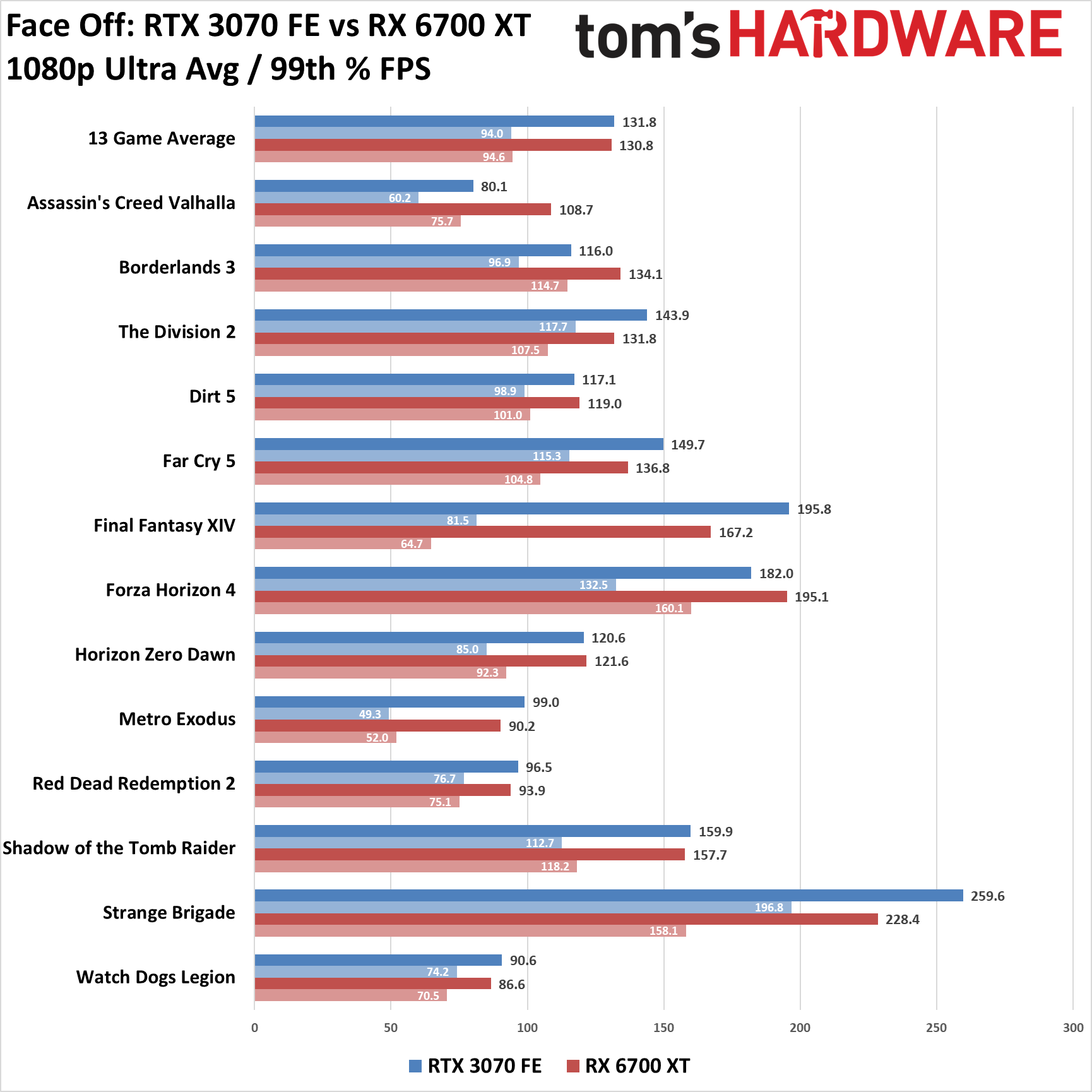
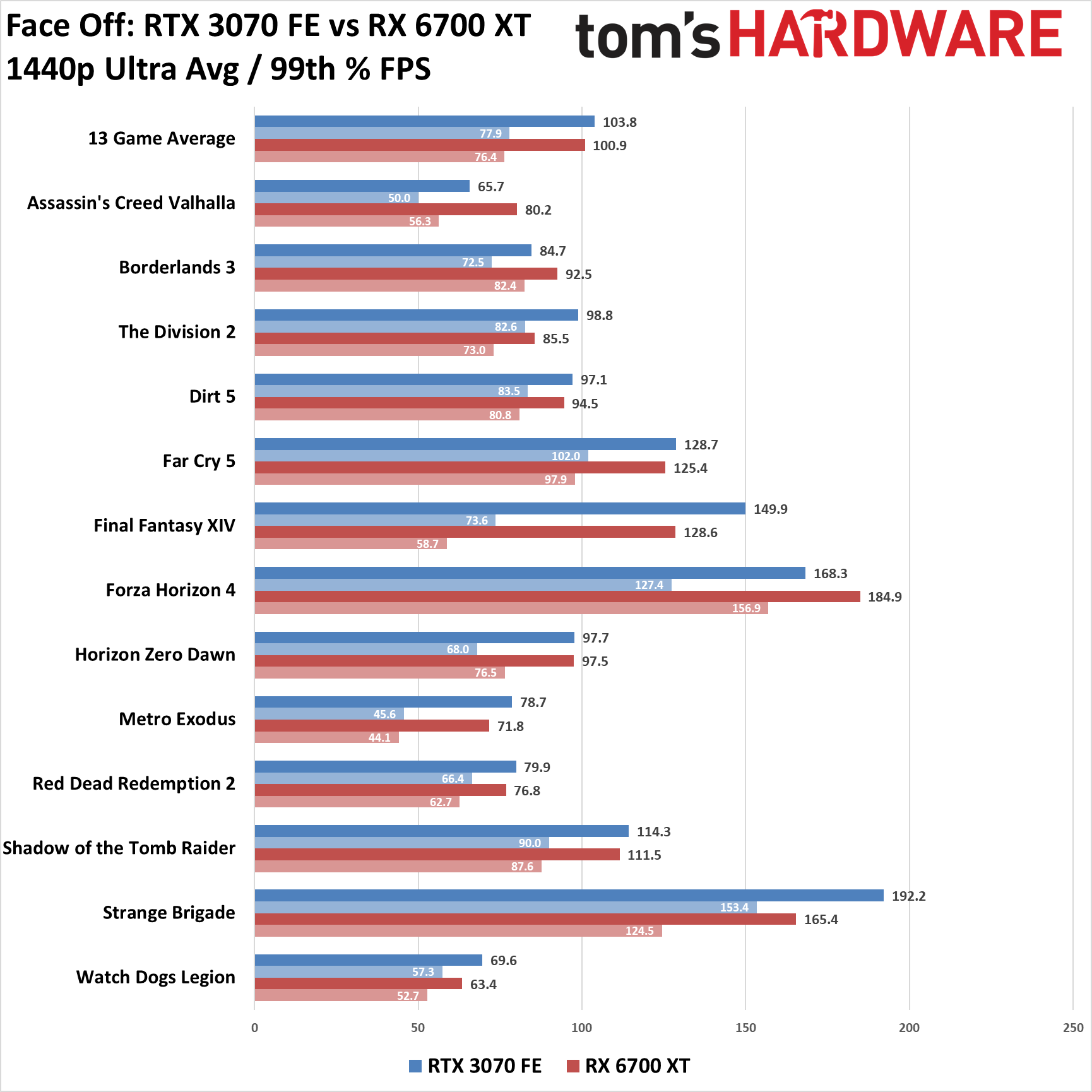

All of the games were tested without ray tracing enabled (if it's supported), so we're looking at traditional rasterization performance. Overall, 1080p ends up effectively tied, with the RTX 3070 posting a negligible 1% lead. That doesn't mean Nvidia wins every game, however, and a few games strongly favor AMD — Assassin's Creed Valhalla, Borderlands 3, and Forza Horizon 4 all go to the RX 6700 XT, with Valhalla showing a 26% deficit. There's a catch, naturally: Valhalla is the first game in the Assassin's Creed series to utilize DirectX 12, and we know from experience that it's entirely possible for a developer to favor one GPU over another with low-level APIs. Valhalla and Borderlands 3 are both AMD promoted games, so those results generally aren't typical.
The flip side is also true: Watch Dogs Legion and Metro Exodus are Nvidia promoted games that favor the 3070 more. While we're on the subject, for the record, The Division 2, Dirt 5, Far Cry 5, and Strange Brigade were also AMD-promoted games. Final Fantasy XIV, Metro Exodus, and Shadow of the Tomb Raider were Nvidia promoted games. That means, all told, we tested with six games promoted by AMD versus four games promoted by Nvidia, and Nvidia still came out ahead (barely).
Kicking up to 1440p and 4K doesn't do AMD any favors. Where the two GPUs are effectively tied at 1080p, the 3070 lead grows to 3% at 1440p ultra and 10% at 4K ultra. That's particularly interesting considering AMD's card has 50% more VRAM. There are situations where the additional memory comes into play, but the Nvidia card has more memory bandwidth, and at higher resolutions, AMD's 96MB Infinity Cache isn't quite as beneficial.
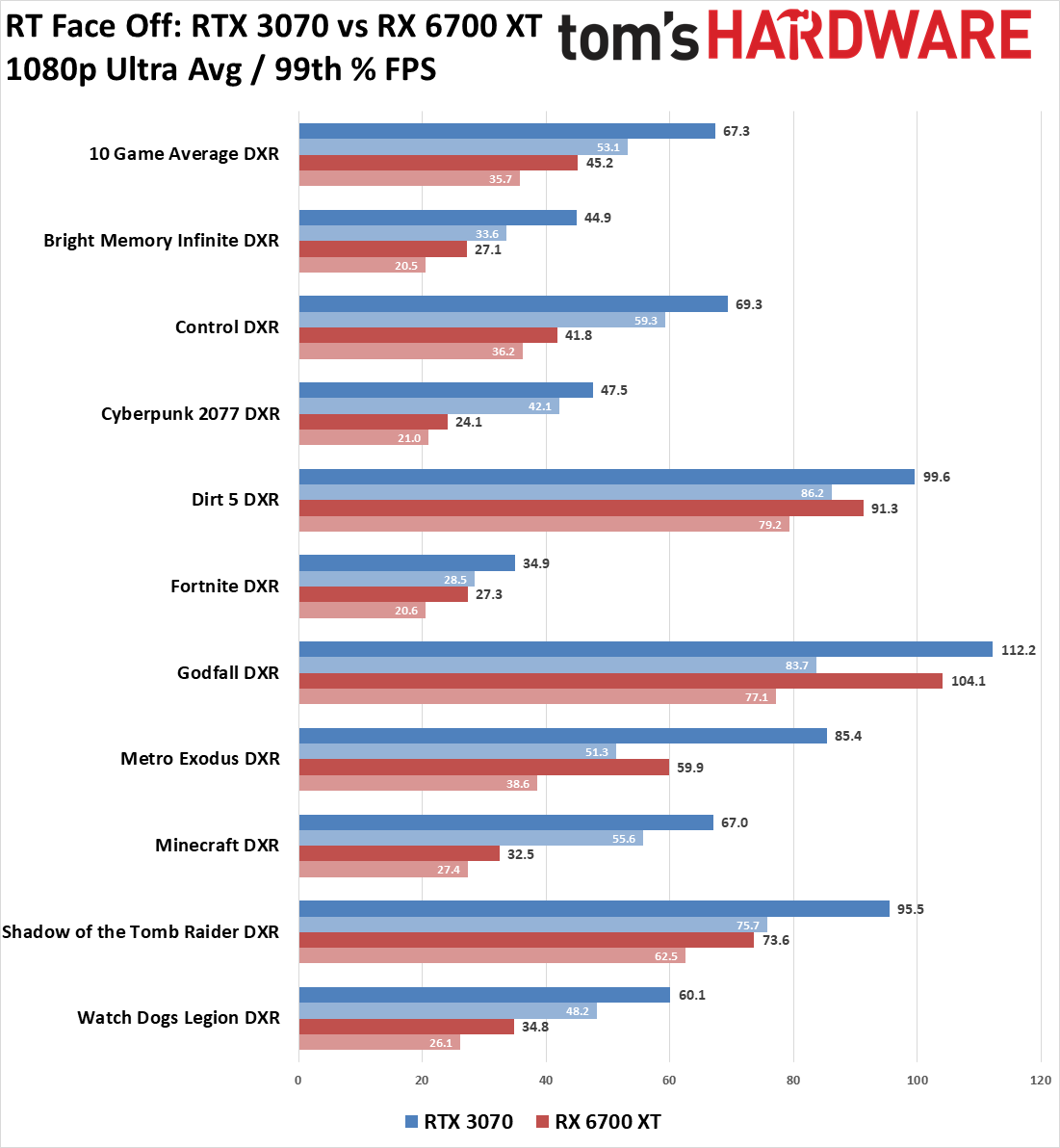

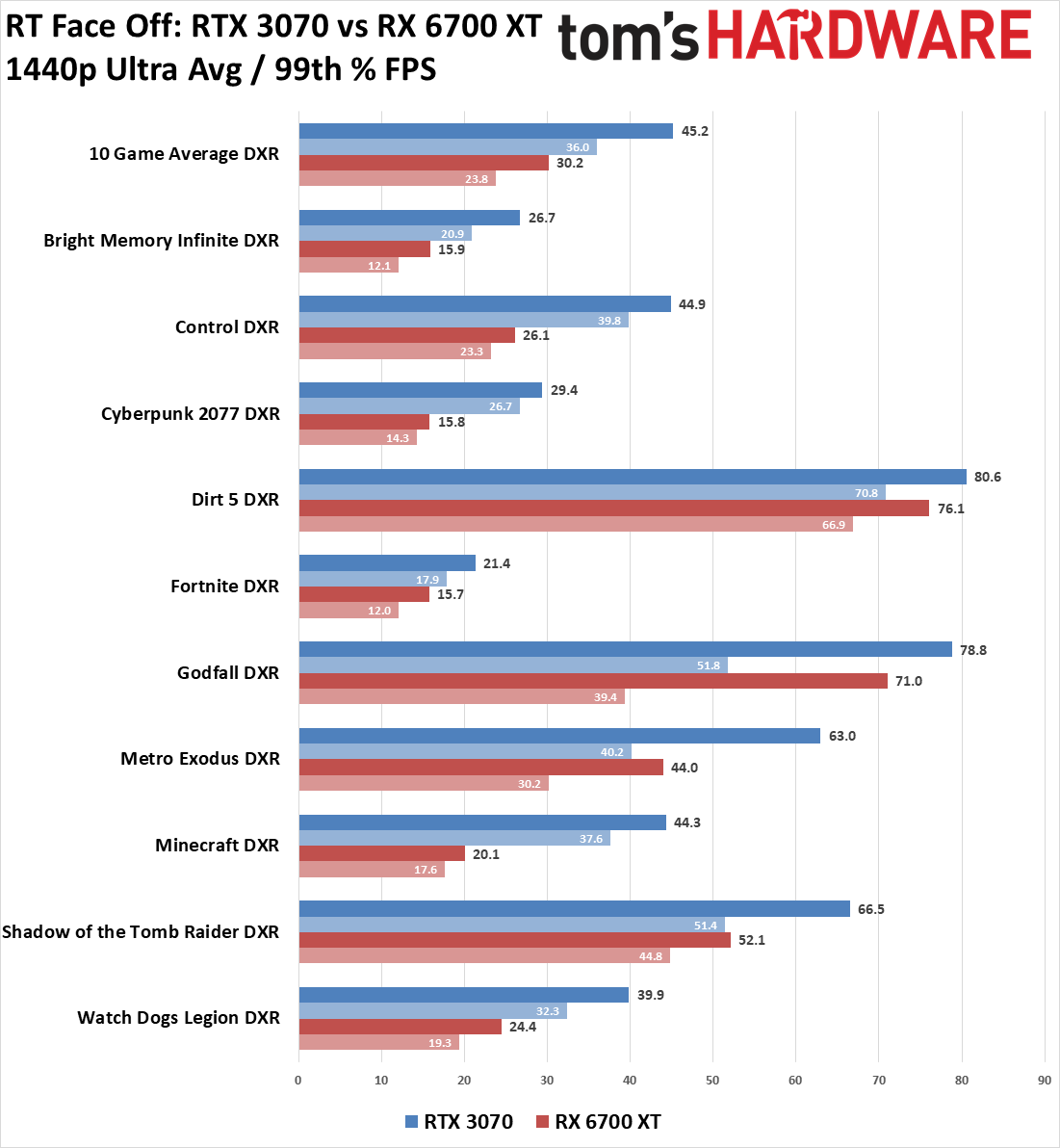
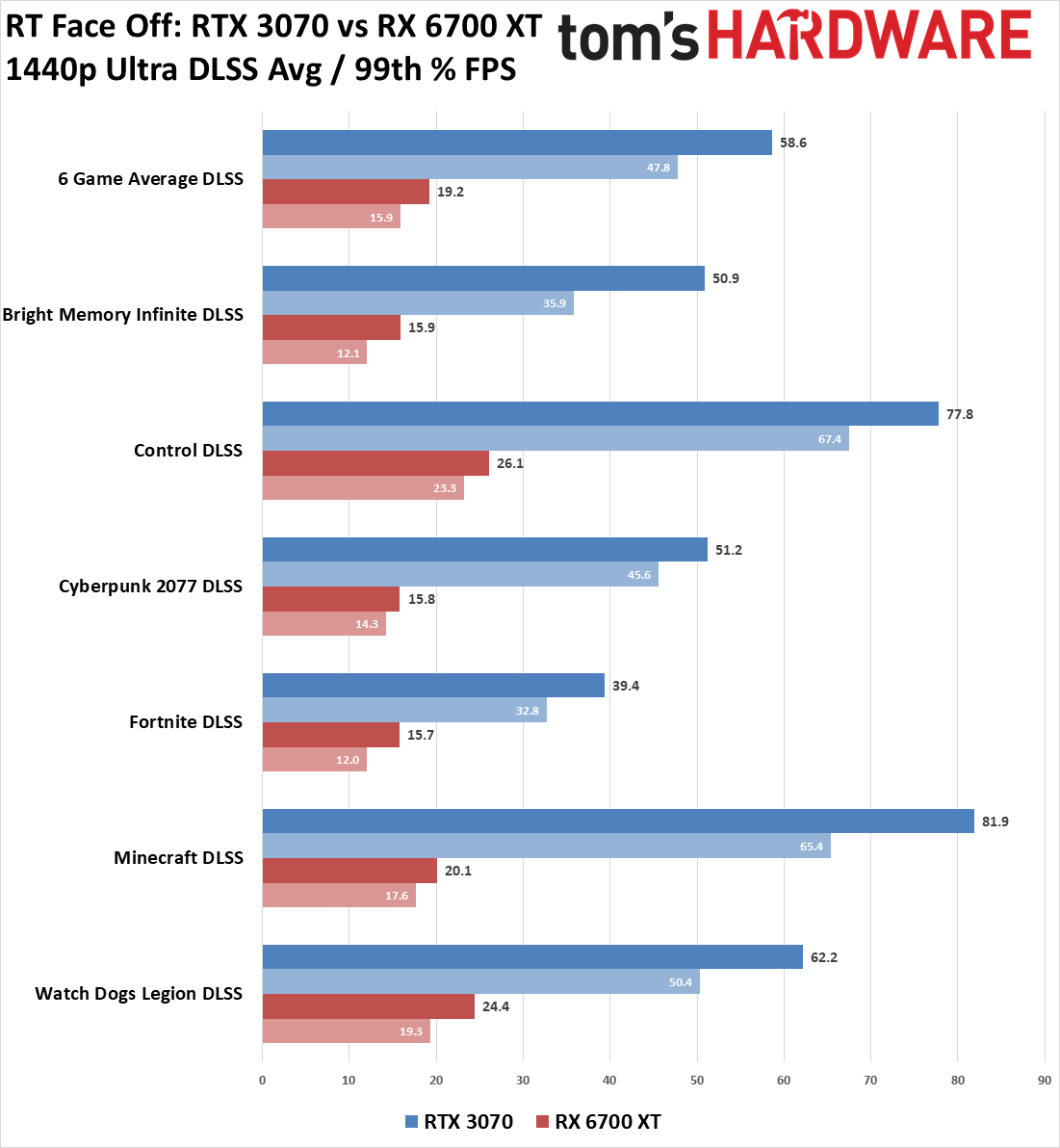
Things only get worse for AMD when we look at games that support ray tracing. The 3070's lead grows substantially with RT enabled, and that's before taking into account Nvidia's DLSS (Deep Learning Super Sampling), which can boost performance by 30-50% or more without any noticeable loss in image fidelity.
Across our 10-game DXR test suite, the RX 6700 XT only gets close to the same performance as the RTX 3070 in the AMD-promoted Dirt 5 and Godfall. The overall lead ends up at just under 50% in favor of the RTX 3070 at both 1080p and 1440p, with a range of 6% (Godfall) to 121% (Minecraft).
Get Tom's Hardware's best news and in-depth reviews, straight to your inbox.
Turn on DLSS Quality and it goes from bad to worse. For the six games we tested, the RTX 3070 outpaces the RX 6700 XT by nearly 200% — the lead is 172% at 1080p and 205% at 1440p. In other words, with RT and DLSS enabled, the RTX 3070 is three times as fast as the RX 6700 XT at 1440p. There's also a growing number of games that don't use ray tracing but still support DLSS, because in the Quality mode it's basically a free performance boost on RTX cards.
FidelityFX Super Resolution (FSR) can't get here soon enough, but we're also skeptical that it can close the gap without compromising on image quality. Right now, the RTX 3070 at 1440p surpasses what the RX 6700 XT manages at 1080p with ray tracing. With DLSS, Nvidia's 1440p performance basically doubles AMD's 1080p performance.
Winner: Nvidia
AMD's RX 6700 XT probably wasn't intended to compete directly with Nvidia's RTX 3070, but the graphics card market is all kinds of messed up right now in terms of pricing tiers. On paper, the RTX 3070 costs $20 more, which basically means the two compete in the same market segment. Nvidia comes away with a minor win in rasterization gaming performance, but its lead only grows with more demanding rendering scenarios like ray tracing. DLSS seals the deal, considering over 30 major games now support the tech, along with Unreal Engine and Unity, and AMD still doesn't have a shipping alternative. If you're after higher frame rates, RTX 3070 beats RX 6700 XT in most of the games we've tested.
Price

We've already mentioned pricing and the discrepancies between official prices and real-world costs. Right now, the cost of a new high-end graphics card is laughable — or it would be if we weren't crying so hard. Remember when the RTX 3090 launched with a starting price of $1,500 and everyone thought that was exorbitant? Right now, you'll have to spend almost that much to nab an RTX 3070 off eBay, and it's about 30% slower than the 3090.
AMD's RX 6700 XT, by comparison, looks far more reasonable, with an average eBay selling price of only $984. That means you get a few percent less performance for about 25% less money. Or at least, that's what you'd have to spend if you wanted to take a chance on eBay.
Street pricing at respectable retail outlets is a different story, a story of empty shelves. Newegg as an example shows 19 RTX 3070 cards ranging from $500 (only one of those) up to $830. We have no way of knowing how many of those cards Newegg sells each week, or when more will arrive. Flipping over to the RX 6700 XT, Newegg lists 26 different models with prices ranging from $480 to $830. Nominally, prices appear roughly comparable, but there are definitely more 3070 cards being sold on eBay if that's anything to go by.
The good news is that, unlike the other Big Navi cards, RX 6700 XT seems to be shipping in greater quantities. At the end of March for example, just over 300 were sold on eBay compared to 60–100 each for the RX 6800, 6800 XT, and 6900 XT. At the same time, there were over 800 RTX 3070 cards sold on eBay during the same period.
Winner: AMD sort of, but really nobody
Even if the RX 6700 XT theoretically can be had for a much lower price than the RTX 3070, by paying scalper prices at eBay, it's a pyrrhic victory. Both cards are selling at over twice the MSRP on eBay, and quantities are far too limited. But if you must have one, $900–$1,000 for the RX 6700 XT is a much better deal than $1300–$1400 for an RTX 3070 — unless you're doing cryptocurrency mining. Performance for either GPU ends up being comparable to the RTX 2080 Super, which was readily available for $700 back in 2019 and early 2020. Hind sight and all that, but we strongly advise against paying more than $600 for either of these cards
Features and Tech

The RX 6700 XT and RTX 3070 go toe-to-toe on most features and superficially this category might seem like a tie. Nvidia has ultra-low latency and Reflex technologies; AMD has Anti-Lag. Nvidia has G-Sync; AMD has FreeSync. Nvidia offers GeForce Experience; AMD has Radeon Settings. There's a lot of tit for tat. There are a few items worth pointing out, however.
First, Nvidia DLSS has no direct competition as yet. Don't even get us started on Radeon Boost, which can certainly improve framerates but often causes stutters and frame pacing issues when it starts and stops. In supported games, it's very difficult to spot the differences between DLSS Quality mode and native resolution with TAA — until you look at framerates and DLSS runs 20–50% faster. FidelityFX Super Resolution will need to be very good to catch DLSS, and it will need developer support, and both of those will take time.
Elsewhere, technologies that seem similar still end up favoring Nvidia. G-Sync and FreeSync ostensibly provide the same thing: Tear-free gaming and adaptive refresh rates. Except, in practice, G-Sync tends to work better. G-Sync Compatible can also work with FreeSync displays, while FreeSync can't work on a G-Sync display. Yes, G-Sync monitors tend to cost more, but as the one item you're constantly looking at when using a computer, it's worth spending an extra $100–$200 for a better display. The same goes for Radeon Anti-Lag and Nvidia Ultra-Low Latency and Reflex. Both can improve latency by minimizing buffering, but NULL tends to be a bit better, and games that directly incorporate Reflex deliver far superior latency.
There's one area where AMD does get a clear win: VRAM capacity — actually two areas, as AMD's Infinity Cache also warrants a mention. The RX 6700 XT provides 12GB of GDDR6 clocked at 16Gbps, compared to only 8GB of GDDR6 clocked at 14Gbps on the RTX 3070. If games start to really use more than 8GB of VRAM but less than 12GB, AMD's GPU might improve in the overall performance standings. The catch is that Nvidia's card has more raw bandwidth, and tweaking the settings (e.g. turning down texture resolution a notch) will often eliminate the capacity constraints. Such discussions ultimately lead back to performance, however, which we've already covered.
Winner: Nvidia
While this is certainly more of a subjective pick, we simply find Nvidia's features work a bit better than AMD's alternatives. Team Green and the RTX 3070 notch up another win, though it's by a split judge's decision rather than by knockout. If you feel strongly about VRAM capacities, or prefer open FidelityFX options to proprietary solutions like DLSS, this category could swing the other way. But fundamentally, we feel Nvidia's Ampere architecture is more advanced than AMD's RDNA2 architecture.
Power and Efficiency

Nvidia has generally held an advantage over AMD when it comes to GPU power consumption and efficiency. That started to change with AMD's first generation Navi parts in 2019, helped immensely by the move to TSMC's N7 7nm process. With Ampere, Nvidia upgraded to Samsung's 8N 8nm process, which is more of a refinement of Samsung's 10nm tech. It's not quite at parity with TSMC’s solution, but it's better than the previous generation 12nm process.
Nvidia didn't just shrink the design of Turing when creating Ampere, however. There are major upgrades to the ray tracing hardware, the tensor cores, and the GPU cores. All of that comes at a cost, with Ampere delivering higher performance than Turing while also requiring significantly more power. The RTX 3080 delivers around 35% better performance than the RTX 2080 Ti at 4K ultra, but it also uses nearly 30% more power — 333W in our testing, compared to 259W for the 2080 Ti.
AMD's RDNA2 chips stuck with the same TSMC N7 process as RDNA1, and power consumption also increased for the top tier parts, but AMD didn't really have a competitive part at the extreme end of the performance spectrum. RX 5700 XT has 40 CUs and power consumption of around 215W in our Metro Exodus testing. RX 6700 XT also has 40 CUs and consumes around 215W, but it's about 30% faster than the previous iteration. Alternatively, the RX 6800 XT uses 303W of power (40% more than 5700 XT) and delivers about 80-90% better performance.
The end result of the various architectural changes is that the companies are generally tied when it comes to efficiency. That's especially true when looking at third party cards: Custom RTX 3080 cards often use around 350W of power, and so do custom RX 6800 XT cards — with a few models from both sides pushing into the 400W range. It's a tie in the mid-range segment as well, with the RTX 3060 Ti drawing 206W and the RTX 3070 using 218W, just slightly above and below the RX 6700 XT.
The budget segment may technically go to Nvidia still, but then the budget segment doesn't actually exist right now with cards like the GTX 1650 Super selling for $400 or more, right alongside the RX 5500 XT.
Winner: Tie
Architecturally, Nvidia's Ampere GPUs come out slightly ahead of AMD's RDNA2, but TSMC's N7 process trumps Samsung Foundry's 8N process. When we factor in all aspects of both sides, power and efficiency are close enough that it's impossible to declare a winner. Like gaming performance, certain workloads may favor AMD while others favor Nvidia when it comes to efficiency and power consumption, but the current generation doesn't show any major flaws on either side.
Drivers and Software

Both AMD and Nvidia offer drivers on a regular cadence, typically with at least one release each month, more when there are a lot of new games coming out. Not surprisingly, depending on the game, performance and support can swing wildly in favor of one side or the other. A few examples from the past year are worth mentioning.
Watch Dogs Legion ran better at launch on Nvidia hardware, and even though ray tracing worked on AMD's latest generation GPUs, it was sort of broken — it didn't render all the RT effects correctly. The latest game patches and driver updates have finally rectified that situation, but Nvidia won the WDL match up. That was expected, as Nvidia was also promoting the game. The same thing happened with Cyberpunk 2077. Forget the buggy launch for a moment; the game simply ran better and looked better on Nvidia's RTX cards. Now that a patch is set to finally enable RT support on AMD's new GPUs, Nvidia still holds the performance advantage. Again, it was an Nvidia promotional title, so we'd expect as much.
AMD has promotional games as well, however. Borderlands 3 and Assassin's Creed Valhalla both fall into that category, and both run better on AMD's latest GPUs — sometimes markedly so. But from a higher-level view looking at a wider swath of games, day-0 driver support and performance tends to be far less extreme than the few examples cited here.
What about stability and other aspects of the drivers? While there was a lot of noise about black screens with the first generation Navi cards, we didn't encounter much in the way of problems that couldn't be fixed by a clean driver install. AMD did acknowledge the issue and supposedly patched things up, and we haven't noticed any significant problems in the past year or so. AMD's drivers can auto-update, there are loads of settings and other services that can be useful, and overall the RX 6700 XT drivers have worked fine in our experience.
The same goes for Nvidia's drivers, minus the black screen issues of 2019. Our biggest complaint with Nvidia is the data mining aspect of requiring users to log in — and solve a captcha — but in the grand scheme of things it's not a big deal. We do give GeForce Experience an edge over Radeon Settings when it comes to game optimizations and streaming features, but both sides work well.
Winner: Tie
It's easy to get caught up looking at minutiae when discussing drivers, but the reality is that both AMD and Nvidia have been doing this for a long time, and the current state of GPU drivers hasn't caused us any major grief on either side. If you've only used Nvidia GPUs and drivers for the past five or ten years, they're familiar and offer plenty of features. The same can be said for anyone who has only used AMD GPUs and drivers during that time — except AMD has improved more, so that where we previously would have given Nvidia the edge, AMD has closed the gap in the past few years. We switch between both vendors' products on a regular basis, which can be a bit problematic sometimes (hint: Display Driver Uninstaller works great to truly clean out most cruft), and rarely have any cause for complaint.
| Round | AMD Radeon RX 6700 XT | Nvidia GeForce RTX 3070 |
|---|---|---|
| Gaming Performance | ✗ | |
| Price | ✗ (nominally) | |
| Features and Technology | ✗ | |
| Power and Efficiency | ✗ | ✗ |
| Drivers and Software | ✗ | ✗ |
| Total | 3 | 4 |
Bottom Line
The Radeon RX 6700 XT and GeForce RTX 3070 are closely matched, with several ties. Even the categories where one side comes out ahead are close, but overall we give the Nvidia GeForce RTX 3070 a slight lead. That's largely thanks to its superior performance — vastly superior performance if we include ray tracing and DLSS in the mix.
Price and availability end up being more important than any other factor, however, and unfortunately neither GPU ranks very well in those respects. Whichever company can produce the most cards will inevitably win the overall battle. Right now, based on what we're seeing from the Steam Hardware Survey at least and our GPU pricing index, Nvidia leads in availability — the RTX 3070 currently ranks as the most used latest generation GPU. (Grains of salt with regards to Steam's obscure statistics, naturally.)
It will be a wonderful day when either of these graphics cards sell at MSRP or less. That's extremely unlikely to occur any time during 2021, unfortunately, and we could see the next generation RTX 40-series and RX 7000 series by the time things settle down. That’s assuming things actually do return to normal, of course. But that's a depressing thought so let's not go there.
Anyone that actually manages to acquire either of these GPUs should be happy with the result. Performance tends to match the previous generation RTX 2080 Super, and beats the old RTX 2070 Super by about 15% as well. It's not a massive improvement in generational performance, but it is an improvement — or it would be if you could buy these at retail without having to jump through Newegg Shuffle and auto-notify shenanigans.
MORE: Best Graphics Cards
MORE: GPU Benchmarks and Hierarchy
MORE: All Graphics Content

Jarred Walton is a senior editor at Tom's Hardware focusing on everything GPU. He has been working as a tech journalist since 2004, writing for AnandTech, Maximum PC, and PC Gamer. From the first S3 Virge '3D decelerators' to today's GPUs, Jarred keeps up with all the latest graphics trends and is the one to ask about game performance.
-
punkncat In this article we rub in your face the features of the unobtainable and pour salt in your wound of desire.........ahahahahahaaha /evilhandwringingReply
My feelings are hurt. ;) -
davidgirgis Typo:Reply
Price and availability end up being more important than any other factory, however, and unfortunately neither GPU ranks very well in those respects.
Should be:
Price and availability end up being more important than any other factor, however, and unfortunately neither GPU ranks very well in those respects. -
RagedAPE I liked the article but it should of waited to include the curb stomp Nvidea raytracing will do to this amd card for a real 1v1. Nobody is playing with raytracing off if you have the option to have it on, after playing with RT in it's full glory I just can not turn back personally it's night and day now.Reply -
Phaaze88 Reply
First person shooters? Racing? Other high fps titles?RagedAPE said:Nobody is playing with raytracing off if you have the option to have it on,
Performance hit too high? Turn on DLSS - that's the point of it - but image quality takes a hit too if one isn't at least on 1440p, or doesn't like to stand around an just look at scenery.
Nvidia has it limited to AAA and other future AAA titles.
I don't have a very big library, and I know I don't speak for everyone, but it's not all that appealing when only a handful of my 50+ games support it, and to varying degrees of detail.
The technology is for sure interesting, but it's just not there yet, and will take quite some time for 'everyone' to adopt it at the pace Nvidia is going at. -
RagedAPE Those are competitive games, it goes without saying not to have raytracing on. I just snapped up control ultimate edition for £13.99 on sale atm ray tracing time!Reply -
Phaaze88 Reply
I admire your enthusiasm! (y)RagedAPE said:Those are competitive games, it goes without saying not to have raytracing on. I just snapped up control ultimate edition for £13.99 on sale atm ray tracing time! -
sizzling ReplyRagedAPE said:Nobody is playing with raytracing off if you have the option to have it on,
I have it set to off in Modern Warefare and Cold War with my 3080 and 3700x while running 1440p. Even at its lowest settings it wipes about a 1/4 off the FPS and I notice that in game. It also really doesn’t add that much to the multiplayer visuals, I’m not sitting there comparing screenshots side by side. -
Heat_Fan89 Reply
Yeah, i'm in the same boat as you. For me RT is more of a "ooh that looks nice" but doesn't add to the game itself. It's the same with motion blur or bloom when Microsoft started using that feature in Microsoft Flight Simulator X back in 2006. I turn both off and i've seen screenshots of RT in games and my reaction is, meh. It doesn't add to the game.sizzling said:I have it set to off in Modern Warefare and Cold War with my 3080 and 3700x while running 1440p. Even at its lowest settings it wipes about a 1/4 off the FPS and I notice that in game. It also really doesn’t add that much to the multiplayer visuals, I’m not sitting there comparing screenshots side by side.
HOWEVER, that's just me, others might put a lot more importance on RT and other visual effects.